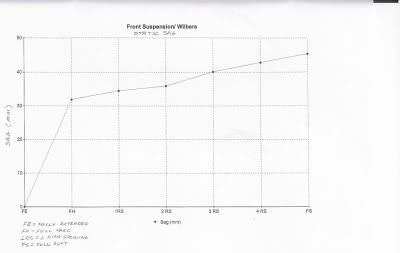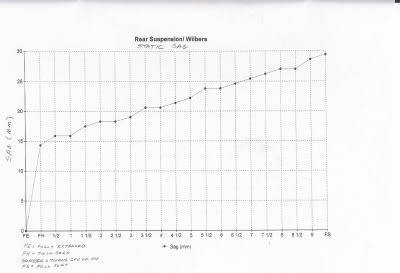Leghorn
Well-known member
Having finally finished the installation of my new Wilbers springs and shock, it was time to select the initial suspension settings. There's a ton of good suspension info out there, most of which has probably been referenced on this forum. Having read every article I could locate, I defaulted to the general guidelines that were provided with my Wilbers package. Here's how I did it. YMMV.
Static Sag/The Front: Wilbers recommends a "road" setting (as opposed to "race") static sag of approximately 25-30% of the total maximum suspension travel. Therefore, with a fork stroke of 135mm, I was looking for a static sag in the range of 33.8-40.5mm. First, I got some help from my very capable wife. She took an initial measurement from the top of the fork seal to the bottom of the lower triple clamp, while I elevated the front wheel to fully extend the suspension. We compared this measurement to six additional measurements: full soft (preload adjusters backed fully up), 4 lines showing, 3 lines showing, etc. to full hard (no lines showing, preload adjusters flush with top of the fork cap). As you can see from the following graph, static sag varied from 31.9-45.3, full hard to full soft. This range works out to be 24-34%, nicely bracketing the range that I was looking for.

Static Sag/The Rear: Wilbers recommends a setting of 10-15% of total maximum suspension. Rear stroke=125mm; therefore, desired static sag range is 12.5-18.75mm. First, I made a "V" with two short pieces of electrical tape and placed the apex of the "V" on the fender plastic directly above the rear axle. While the bike was on the center stand I took an initial measurement from the axle nut with the suspension fully extended. This is the measurement that I compared to all other measurements. My shock has the remote preload adjuster. While determining the factory setting on the adjuster, I learned that there is a discernable detent "click" for every 180 degrees of turn. For that reason I decided to take readings for every 1/2 turn of the knob. There turned out to be 9 full turns plus a little on either side for full hard and full soft. Per the chart below, I measured a static sag of 14.3-29.4mm, full hard to full soft, which works out to a range of approximately 11-24% of the total stroke. (This sounds like too soft a spring to me, but it's a bit early to know for sure as I haven't test ridden the bike yet. According to my paperwork, my spring is a 59/59-95-150. My rider weight is 180, including riding gear. Typical cargo weight is 35 pounds. I've sent Klaus an e-mail to get his thoughts.)

Dynamic Sag: Based on the above static sag data, I selected a setting of 3 rings showing (40.1mm) for the forks and 3 turns off of full hard (19mm) for the shock, as starting point to find a suitable dynamic sag. According to the Wilbers info, the goal for dynamic sag is about 33% of total stroke. After a series of measurements and adjustments, I ended up setting the fork preload at 4 lines showing and the shock preload at 1 turn off of full hard, yielding percentages of 32 and 35.5, respectively. (Again, my settings are merely pre-test ride starting points.)
Compression and rebound came factory preset on the Wilbers shock. I will make no changes on those adjusters until I'm satisfied with sag and the fore and aft attitude of the bike. For the compression and rebound settings on the forks, I will probably center everthing and refine it from there.
I'll post a follow up when I know more.
Static Sag/The Front: Wilbers recommends a "road" setting (as opposed to "race") static sag of approximately 25-30% of the total maximum suspension travel. Therefore, with a fork stroke of 135mm, I was looking for a static sag in the range of 33.8-40.5mm. First, I got some help from my very capable wife. She took an initial measurement from the top of the fork seal to the bottom of the lower triple clamp, while I elevated the front wheel to fully extend the suspension. We compared this measurement to six additional measurements: full soft (preload adjusters backed fully up), 4 lines showing, 3 lines showing, etc. to full hard (no lines showing, preload adjusters flush with top of the fork cap). As you can see from the following graph, static sag varied from 31.9-45.3, full hard to full soft. This range works out to be 24-34%, nicely bracketing the range that I was looking for.

Static Sag/The Rear: Wilbers recommends a setting of 10-15% of total maximum suspension. Rear stroke=125mm; therefore, desired static sag range is 12.5-18.75mm. First, I made a "V" with two short pieces of electrical tape and placed the apex of the "V" on the fender plastic directly above the rear axle. While the bike was on the center stand I took an initial measurement from the axle nut with the suspension fully extended. This is the measurement that I compared to all other measurements. My shock has the remote preload adjuster. While determining the factory setting on the adjuster, I learned that there is a discernable detent "click" for every 180 degrees of turn. For that reason I decided to take readings for every 1/2 turn of the knob. There turned out to be 9 full turns plus a little on either side for full hard and full soft. Per the chart below, I measured a static sag of 14.3-29.4mm, full hard to full soft, which works out to a range of approximately 11-24% of the total stroke. (This sounds like too soft a spring to me, but it's a bit early to know for sure as I haven't test ridden the bike yet. According to my paperwork, my spring is a 59/59-95-150. My rider weight is 180, including riding gear. Typical cargo weight is 35 pounds. I've sent Klaus an e-mail to get his thoughts.)

Dynamic Sag: Based on the above static sag data, I selected a setting of 3 rings showing (40.1mm) for the forks and 3 turns off of full hard (19mm) for the shock, as starting point to find a suitable dynamic sag. According to the Wilbers info, the goal for dynamic sag is about 33% of total stroke. After a series of measurements and adjustments, I ended up setting the fork preload at 4 lines showing and the shock preload at 1 turn off of full hard, yielding percentages of 32 and 35.5, respectively. (Again, my settings are merely pre-test ride starting points.)
Compression and rebound came factory preset on the Wilbers shock. I will make no changes on those adjusters until I'm satisfied with sag and the fore and aft attitude of the bike. For the compression and rebound settings on the forks, I will probably center everthing and refine it from there.
I'll post a follow up when I know more.



